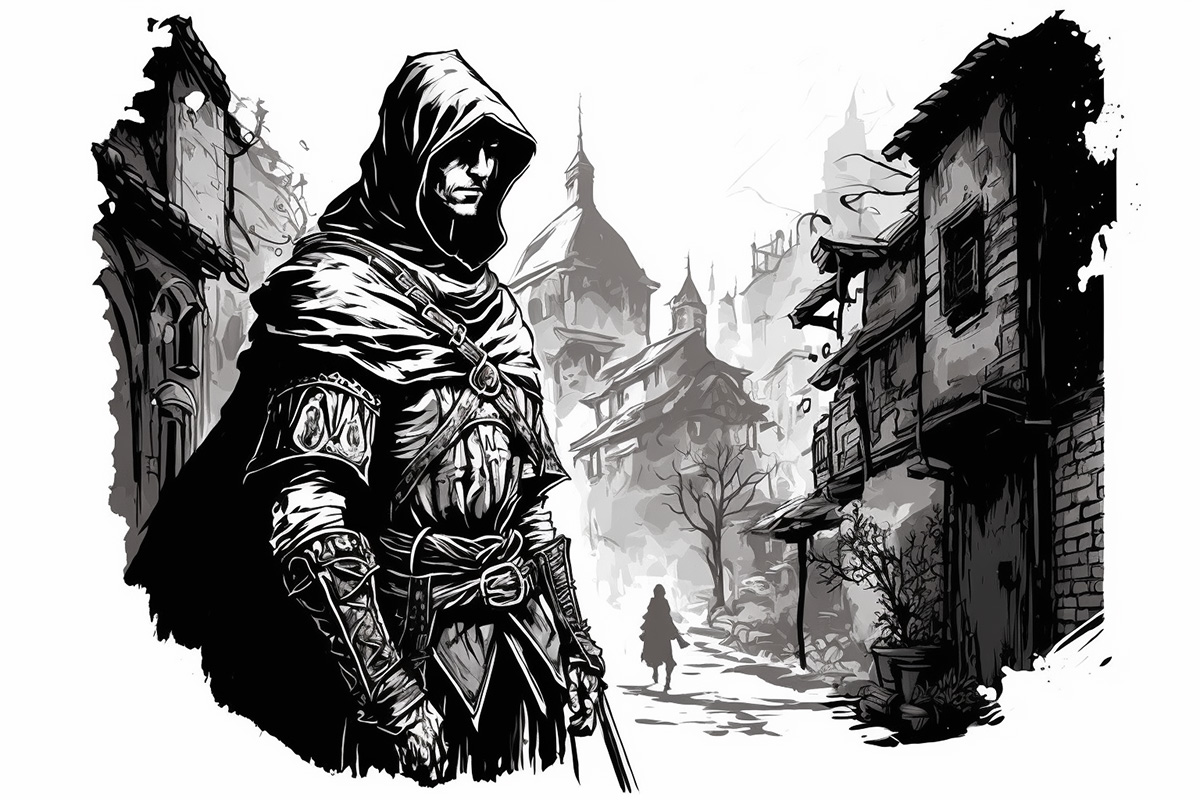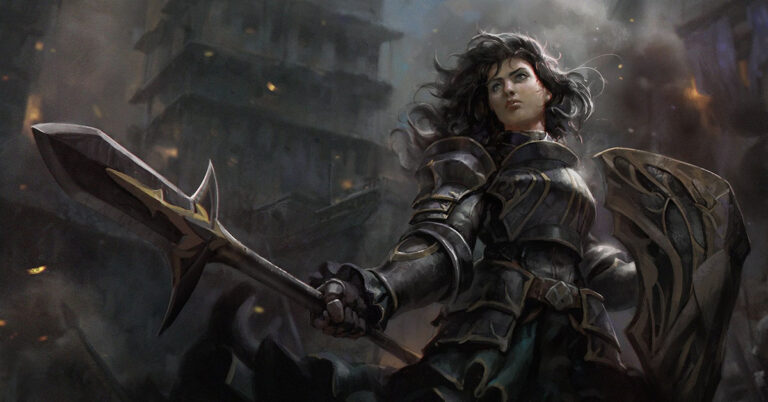Likely to catch your DM off guard, the Polearm Master feat can really change the dynamic of combat in DnD, giving you much more agency and control of the battlefield.
Let’s break down how the feat works, what the best combos are and how you can make a defensive warden to protect your party.

Table of Contents
What does Polearm Master do in 5e?
The first feature allows you to make an additional attack with the blunt end of your weapon of choice as a bonus action, if and only if you’ve taken the Attack action on your turn. This bonus attack uses the same attributes as the main attack, but only deals 1d4 damage plus your ability modifier.
The second part of the feat allows you to make attacks of opportunity when enemies enter your reach, which can be very useful as you can attack and potentially defeat enemies before they can get to you as many of the Polearm master compatible weapons have a reach of 10ft.
Which weapons can I use with Polearm Master?
To make use of the Polearm Master feat you’ll be required to use one of these weapons:
- Glaive
- Halberd
- Quarterstaff
- Spear
So make sure you’re packing one of these if you want to go for this feat!
Why is Polearm Master so good?
Polearm Master is one of the most popular feats because it works with a lot of different playstyles, especially for martial characters. The weapon choice is varied, including options for 1-handed, 2-handed, or even thrown weapons. Check page 149 of the Player’s Handbook for information on weapons. This gives many classes an option for the bonus action, which can be sorely missed if you don’t have something like Rogue’s Cunning Action, or the Monk’s Flurry of Blows. The extra attack allows for more chances to deal damage and apply on-hit effects, including Paladin’s Divine Smites and Fighter’s Battle Manoeuvres
The second part, allowing more opportunity attacks gives characters more control of the battlefield, and chances to dish out even more damage off their turn, which is highly valuable. If you can build other aspects of your character around using opportunity attacks, Polearm Master is going to allow you to use that more.
Overall, the single feat can grant up to two additional attacks per round, if you’re able to get an attack of opportunity in, which can double your damage per round.
Why are Sentinel and Polearm Master so good together?
Sentinel and Polearm Master are two feats that go together extremely well as they synergise due to the first two points of Sentinel feat, which read:
“When you hit a creature with an opportunity attack, the creature’s speed becomes 0 for the rest of the turn. Creatures provoke opportunity attacks from you even if they take the Disengage action before leaving your reach.”
Let’s breakdown what happens if you take these two feats and an enemy approaches you on the battlefield:
- The enemy approaches you, entering your reach, allowing you to make an attack of opportunity via the Polearm Master feat.
- You manage to hit with this attack of opportunity, forcing their speed to become 0 due to Sentinel.
- If you’re using a weapon with 10ft reach, and the enemy does not also have 10ft reach, they can’t hit you, nor can they move any closer to you on this turn.
- Now it’s your turn, where you use the attack action, and then as a bonus action you get an additional attack from Polearm Master
- Back to the enemy, who likely regrets their decision and tries to run away. Even if they disengage you can still hit them with an opportunity attack, from Sentinel.
- If you hit them again, their speed is reduced to zero, and they cannot move any further away from you
- On your turn, you catch up to them and repeat the whole process.
This combination of feats creates a crazy amount of battleground control, especially against just one enemy on who you can focus your efforts. The enemy is stuck next to you, which can cause problems if they want to attack anyone else.
Other good feats to combine with Polearm master
If you’re planning to take Polearm Master, you may also be planning what else to do with your other feats/ASIs to complement.
We’ve already mentioned Sentinel, and how good a pairing it is, but there are some others that work well too:
Great Weapon Master: While this feat overlaps with the bonus action attack (which is strictly better but only usable some of the time), the second part of the feat is what we’re aiming for. If you can compensate for the -5 to hit, the extra 10 damage can be applied on all attacks given by Polearm Master, which can greatly increase the damage provided by this feat. Do note that you need to use a heavy weapon to activate Great Weapon Master, so only the glaive and halberd work with this feat pairing.
Martial Adept: Some of the fighter’s Battle Manoeuvres work very well with Polearm Master as you have more chances to use them. Picking options such as Trip Attack, to push enemies prone for advantage, Distracting Strike to buff your allies’ attacks or Manoeuvring Attack or Menacing Attack can increase your damage output even further and provide more combat utility. You can use these manoeuvres on any of the attacks granted by Polearm Master, so feel free to experiment with applying your effects at different times to see what gives the most benefit.
ASI: It may also be wise to forgo another feat and use an ASI to increase your stats, especially one that you use to make your attacks. This will help you make the most of the additional attacks you gain from Polearm Master, increasing your damage output even more.
How do you play Polearm Master in 5e?
If you’re interested in really leaning into your polearm mastery, there are several different recommendations that can really make this feat shine.
Best races to play with Polearm Master
I recommend taking the Variant Human race, as it allows you to take the feat at level 1, meaning you can start using it from session 1, setting up the playstyle of the character right away.
Another good pick is the Half-Orc, with their Savage Attacks, you get to roll an additional damage die whenever you score a critical strike, and with the extra attacks from the feat, you’re more likely to proc this extra damage. The Half-orc’s Relentless Endurance also really helps you stay up if you’re in the thick of the fight, giving you that second life if you get knocked unconscious. Do note that you’ll have to wait until level 4 to get the Polearm Master feat if you play as a Half-Orc.
Best classes to play with Polearm Master
For classes, most of the strength-based martial classes work best, including Barbarian, Fighter and Paladin, even Rangers could work if built correctly.
As none of the weapons that work with Polearm Master are finesse, you’ll be relying on Strength to make your weapon attacks, so these classes work best as they already use Strength the most.
All these classes have big hit dice, meaning you’re going to have more health which you’ll need if you’re planning to be in the middle of the fight, which, of course, you will be to make the best use of the feat.
Depending on your subclass, the barbarian can sometimes have a lack of bonus actions, which this feat makes up for with extra damage. The fighter and paladin can both apply their on-hit effects on the bonus attacks, so they’ll always be happy with more chances to attack. The ranger can also apply extra on-hit effects such as Hunter’s Mark, but they’ll need to be more careful as their damage often comes from spells.

Best attributes to take for Polearm Master
In terms of attributes, you’ll need Strength to make your attacks, so prioritise that. For secondary attributes, you may want to focus on Constitution next to further increase your health if you are the primary target for enemies. Depending on your armour choice you may also want to increase Dexterity to boost your Armour Class.
The mental attributes have no real synergy with Polearm master (unless you’re using it as a melee Druid with Shillelagh), so drop those in favour of the physical stats.
Best weapons for Polearm Master
For your weapon of choice, you only have 4 to pick from. If you have proficiency in martial weapons, either the glaive or halberd is best (they are statistically the same except for cost and weight). They have a 10ft reach and the highest damage die at d10. However they are two-handed weapons so you won’t be able to use a shield, so watch your AC. Another thing to note is that both the glaive and halberd are ‘Heavy’ weapons, which means small creatures have disadvantage while using them. Speak to your DM about this rule if you’re really wanting to play a small race with this feat.
If you’re concerned about being too easy to hit, you could opt for a spear to allow you to throw the weapon, or a quarterstaff which can be used in either 1 or 2 hands, depending on your needs. Pairing either of these with a shield in the off-hand will grant you a very beneficial +2 to AC.
Tips for using Polearm Master feat
You’ll want to play defensively if you’re taking Polearm Master, especially if you’re pairing it with the Sentinel feat. You gain the benefits of Polearm Master when enemies enter your range, so you need to let them come to you before using those additional attacks of opportunity.
Also, make sure your bonus action is free, or at least not commonly used, so that you can make those extra strikes without missing out on another option. Finally, make sure you chat with your party about your play style. This can be done either in or out of the game to allow you to strategize and best use your feature. Sometimes the difference of an extra attack can swing the battle in your favour and turn a defeat into a victory. Communication is super key in DnD to make sure everyone is involved and having fun.
Who should avoid Polearm Master?
Polearm Master only really works for martial characters, as classes like Sorcerers and Wizards are more likely to be slinging spells from afar rather than being in the thick of it to utilise the extra opportunity attack options. Additionally, this feat should be avoided by characters that already have plenty to do with their bonus action, as they won’t be able to gain the extra benefit of the extra attack.
Also, note that Rogue always want to proc their Sneak Attack, which requires a ranged or finesse weapon to use. None of the weapons that Polearm Master requires are finesse or ranged, so they will not synergise here, rendering the feat useless for rogues.

So there you have everything you need to know about Polearm Master and how best to use it! If you want to play as a uniquely defensive character who can control the battlefield, consider picking up a glaive, halberd or quarterstaff alongside this feat and have fun locking down enemies before they can even reach you!
